School choice, political controversy, and education policy are at the heart of a complex and ongoing discussion in the realm of education. The school choice system, which aims to give parents more power in deciding their children’s education, has emerged as a significant topic that not only involves educational aspects but also stirs up intense political debates.

The Concept of School Choice System
The school choice system is a policy that allows parents to select schools for their children beyond the traditional neighborhood-based assignment. This concept is rooted in the idea of providing educational freedom and competition among schools. For example, parents may choose a charter school, a magnet school, or a private school instead of sending their child to the local public school. According to Wikipedia’s entry on school choice, different types of school choice programs have been implemented in various regions to meet the diverse needs of students and parents. This system is believed to potentially improve educational quality as schools strive to attract students by offering better curricula and teaching methods.

Implementation Models of School Choice
There are several common implementation models of the school choice system. One is the voucher system, where the government provides parents with vouchers equivalent to a certain amount of educational funds. Parents can then use these vouchers to pay for their children’s tuition at the chosen school, whether it’s public or private. Another model is the charter school movement. Charter schools are publicly funded but operate independently, with more flexibility in curriculum and teaching approaches. As stated in Britannica’s article on school choice, these models have been adopted in different parts of the world to varying degrees, each with its own set of advantages and challenges.
However, the implementation of these models is not without issues. For instance, in some areas, the voucher system has been criticized for potentially diverting public funds to private institutions, which may raise concerns about the fairness of resource distribution.
Readability guidance: The above content uses short paragraphs to clearly present the key points. The information about different implementation models is presented in a straightforward manner, and external links are provided to enhance the credibility of the content. Transition words like “however” are used to show the shift in ideas.


